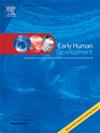早产儿出生后第一年颅骨发育的三维过程。
IF 2.2
3区 医学
Q2 OBSTETRICS & GYNECOLOGY
引用次数: 0
摘要
背景:颅骨测量对于评估早产儿的总体发育至关重要,因为它们是评估大脑发育的替代工具。然而,三维(3D)方法将诊断范围扩展到了颅骨体积和形状的评估。在这项研究中,我们分析了与足月儿(TB)相比,早产儿在出生后第一年出现头颅异常的风险:在这项单中心前瞻性队列研究中,我们对 23 名 vPT 婴儿和 24 名 TB 健康婴儿进行了评估。分别在 vPT 和 TB 出生时的足月等效年龄(TEA),以及月龄后 1、3、6 和 12 个月时,进行 3D 头部扫描,并对头颅生长(头围、头颅体积)和形状进行头颅测量评估:结果:vPT 和 TB 的头围和头颅体积的发育过程相似。vPT和TB的颅骨形状有明显差异。在出生后第 6 个月,这种差异消失。vPT和肺结核患儿最初的颅骨后凸畸形情况相似,但两组患儿的颅骨后凸畸形情况差异越来越大,在6个月时达到顶峰,34.8%的vPT患儿出现中度至重度颅骨后凸畸形,而肺结核患儿则没有(p = 0.004)。在vPT中,颅骨体积与颅骨形状有明显的相关性,而在TEA时的双侧颅骨畸形对颅骨畸形的进一步发展没有影响:结论:就颅形异常而言,vPT 的颅骨发育过程与肺结核不同,而颅骨生长则不受影响。德国临床试验注册编号:DRKS00022558:DRKS00022558。本文章由计算机程序翻译,如有差异,请以英文原文为准。
The three-dimensional course of cranial development of very preterm infants during the first year of life
Background
Cranial measurements are crucial for evaluating preterm general development because they are a surrogate tool for evaluating brain growth. Usually, they are based on tape-measured head circumference; however, a three-dimensional (3D) approach expands the diagnostic spectrum to the evaluation of cranial volume and shape.
Aims
Very preterm (vPT) infants face multiple risks and obstacles in their early development. In this study, we analyze the risk for cranial anomalies of vPT compared with term-born (TB) infants during the first year of life.
Study design and subjects
In this single-centre prospective cohort study, 23 vPT and 24 TB healthy infants were assessed. At term equivalent age (TEA) of vPT and time of birth of TB, and 1, 3, 6 and 12 months of postmenstrual age, respectively, a 3D head scan was performed and cephalometrically evaluated regarding cranial growth (head circumference, cranial volume) and shape.
Results
Head circumference and cranial volume showed a similar course in vPT and TB. Cranial shape differed significantly between vPT and TB. At TEA, vPT showed longer and narrower heads (dolichocephaly), a difference that disappeared around the 6th month of life. Presence of plagiocephaly was initially similar in vPT and TB, with an increasing difference between both groups with a peak at six months when 34.8 % of the vPT versus none of the TB showed a moderate to severe plagiocephaly (p = 0.004). In vPT, cranial volume significantly correlated with cranial shape, whereas dolichocephaly at TEA had no influence on the further course of plagiocephaly.
Conclusion
Cranial development of vPT follows a different course than of TB in terms of cranial shape anomalies, while cranial growth remains unaffected.
German Clinical Trials Register number: DRKS00022558.
求助全文
通过发布文献求助,成功后即可免费获取论文全文。
去求助
来源期刊

Early human development
医学-妇产科学
CiteScore
4.40
自引率
4.00%
发文量
100
审稿时长
46 days
期刊介绍:
Established as an authoritative, highly cited voice on early human development, Early Human Development provides a unique opportunity for researchers and clinicians to bridge the communication gap between disciplines. Creating a forum for the productive exchange of ideas concerning early human growth and development, the journal publishes original research and clinical papers with particular emphasis on the continuum between fetal life and the perinatal period; aspects of postnatal growth influenced by early events; and the safeguarding of the quality of human survival.
The first comprehensive and interdisciplinary journal in this area of growing importance, Early Human Development offers pertinent contributions to the following subject areas:
Fetology; perinatology; pediatrics; growth and development; obstetrics; reproduction and fertility; epidemiology; behavioural sciences; nutrition and metabolism; teratology; neurology; brain biology; developmental psychology and screening.
 求助内容:
求助内容: 应助结果提醒方式:
应助结果提醒方式:


